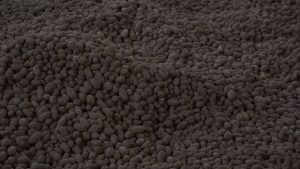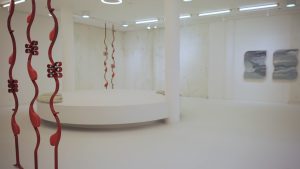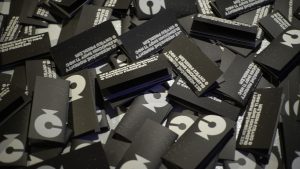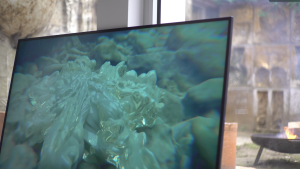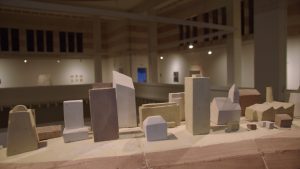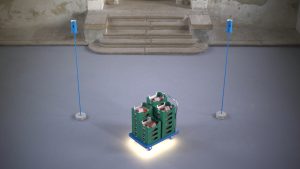Embed
Embed
Martin Knut pod sivou fasádou každodennosti nachádza stopy permanentnej existenciálnej drámy a tento prienik medzi zjavnou a skrytou podobou nášho bytia zachytáva tak, aby sme boli bližšie k jeho porozumeniu.
V tomto zmysle sú jeho obrazy, povedané s Le Cléziom, „zápisom o katastrofe“ , čo ale neznamená, že návštevnosť tejto výstavy sa musí nutne podpísať pod štatistický nárast následných samovrážd. Nositelia jeho príbehov sú zobrazení v redukovanej, minimalistickej linke, sú to figúry bez tváre abez detailne prepracovaných antropomorfných prvkov. Ak by sme tie postavy, čo prišli na svet akoby jedným ľahučkým ťahom, mali pomenovať, asi by sme si zvolili nejakú zdrobneninu. Kompletný maliarsky Knutov rukopis, vrátane výberu farieb a narábania s nimi, na diváka dýcha jemnosťou, vľúdnosťou, tichou senzibilitou, ktorá robí ťažké témy ľahšími a stráviteľnejšími a dokonca im občas dokáže nenápadne nastaviť nohu, aby sa potkli a nebrali sa až tak príliš vážne. Povedzme to teda tak, že autor nás zmieruje s naším ľudským údelom. Že dokáže hovoriť pravdu tak, aby veľmi nebolela. A nepotrebuje na to nijaké anestetikum.
Ďalším identifikačným znakom Knutovej tvorby je jeho vstupovanie do obrazov prostredníctvom písaného slova. Sú to výroky a sentencie nie nepodobné aforizmom, ktoré by obstáli aj samostatne, ale v kombinácii s obrazovou výpoveďou vzniká zaujímavý synergický efekt.
Tvorba Martina Knuta je čímsi ako intímnou spoveďou, nahliadnutím do trinástych komnát človeka, ktorý ešte nerezignoval na hľadanie pravdy o sebe a o svete. Pri koncipovaní výstavy som chcel preto vytvoriť priestor navodzujúci pocit „domáckej“ intimity. Našťastie už samotná dispozícia galérie, pripomínajúca priestory bytu (ilúziu dotvára inštalovaný mobiliár) vyšla tejto myšlienke v ústrety. Priestor je ponorený do prítmia, narušeného iba bodovými svetlami „namierenými“ na vystavené diela. Diery do svetla – ako znie názov výstavy – sú metaforou narúšania vonkajšej, často kašírovanej podoby každodenného sveta, ktorú autor demaskuje vo svojich príbehoch. Dôležitosť odkrývania významových vrstiev pripomína aj ponuka k interaktívnej hre: pri niektorých dielach sú zavesené malé ručné baterky, ktorými si divák môže zasvietiť do útrob dier na obrazoch. Pohybom svetelného zdroja sám môže animovať tieňohru a skúmať nové dojmy a významy, ktoré mu prinesie hra svetla a tieňa.
Peter Uličný
Martin Knut finds traces of a permanent existential drama beneath the grey façade of the everyday, and he captures this interpenetration between the overt and the covert forms of our existence in a way that brings us closer to an understanding of it.
In this sense, his paintings are, to use Le Clézio’s phrase, “a record of catastrophe” , which is not to say that the attendance at this exhibition necessarily accounts for the statistical increase in subsequent suicides. The bearers of his stories are depicted in a reduced, minimalist line; they are figures without faces and without detailed anthropomorphic elements. If we were to name these characters, who came into the world as if in one light stroke, we would probably choose a diminutive. Knut’s complete painter’s handwriting, including his choice of colours and the handling of them, breathes with a gentleness, a kindness, a quiet sensibility that makes difficult subjects lighter and more digestible. It even manages to subtly set them on their feet at times, so that they stumble and don’t take themselves too seriously. Let’s just say, then, that the author merges us to our human lot. That he can speak the truth in a way that doesn’t hurt too much. And he doesn’t need an anesthetic to do it.
Another identifying feature of Knuth’s work is his entry into images through the written word. These are sayings and sentences not unlike aphorisms, which would stand on their own, but in combination with the pictorial statement an interesting synergistic effect is created.
Martin Knut’s work is something like an intimate confession, a glimpse into the thirteenth chamber of a man who has not yet resigned himself to the search for the truth about himself and the world. In conceiving the exhibition, I therefore wanted to create a space evoking sense of “domestic” intimacy. Fortunately, the very layout of the gallery, reminiscent of the spaces of an apartment (the illusion is completed by the installed furnishings), has already met this idea. The space is immersed in darkness, disturbed only by spot lights “directed” on the exhibited works. Holes into the light – as the title of the exhibition reads – are a metaphor for the disruption of the external, often mashed-up form of the everyday world that the artist unmasks in his stories. The importance of uncovering layers of meaning is also reminded by the offer to play an interactive game: small torches are hung next to some of the works, which the viewer can use to shine a light into the bowels of the holes in the paintings. By moving the light source himself, he can animate the shadow play and explore the new impressions and meanings brought about by the play of light and shadow.
Peter Uličný
